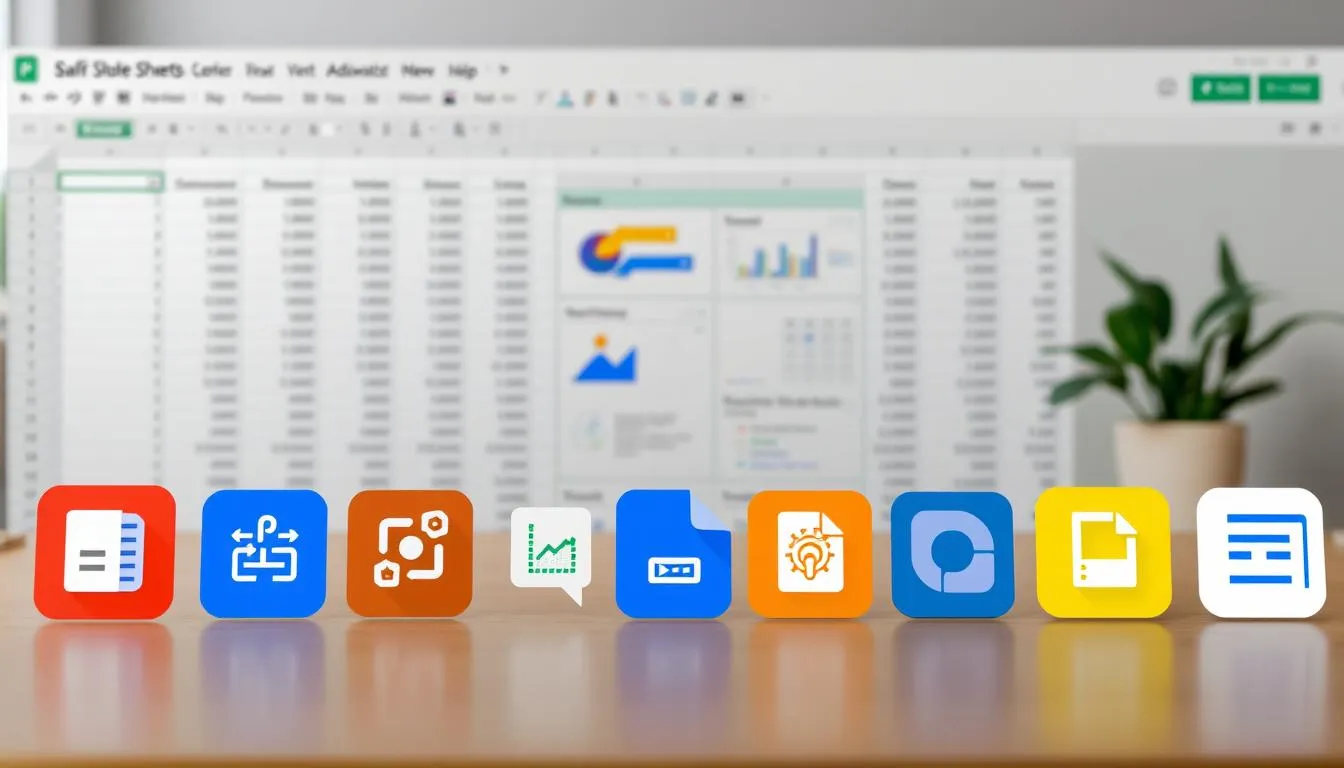“Time is money, but wasted time is bankruptcy.” – Warren Buffett’s words ring painfully true for professionals drowning in manual spreadsheet work. What starts as a simple data entry task often snowballs into hours of repetitive formatting, formula checks, and error hunting.
Consider J.P. Morgan’s infamous $6.5 billion loss from a copy-paste mistake – a stark reminder that human error hides in every cell. Modern teams can’t afford spreadsheet blunders or wasted hours when strategic decisions demand attention. That’s where intelligent tools step in, transforming static documents into dynamic productivity engines.
Imagine your spreadsheets updating themselves while you focus on high-impact analysis. Picture dashboards that refresh automatically, formulas that self-correct, and alerts that trigger when data shifts. This isn’t futuristic fantasy – it’s achievable today through three accessible methods we’ll explore.
Key Takeaways
- Manual spreadsheet errors cost companies billions annually, as seen in J.P. Morgan’s historic loss
- Automated systems eliminate repetitive tasks like data entry and formula updates
- Real-time synchronization ensures teams always use current information
- Simple tools like Macros require zero coding experience to implement
- Custom alerts and validations prevent costly data entry mistakes
Understanding Google Sheets Automation
Ever accidentally deleted a critical formula or copied values to the wrong column? These small mistakes ripple through organizations like dominoes. One hospital’s billing error – a misplaced decimal in patient records – caused $12 million in delayed payments last year. Manual processes aren’t just tedious; they’re financial landmines.

Why Automate Routine Tasks?
Repetitive actions drain creativity and invite errors. Employees spend 30% of their workweek on manual data transfers – time better spent analyzing trends or improving customer experiences. Standardized workflows ensure identical results whether it’s 2 PM or 2 AM.
Automated systems catch discrepancies humans might miss. Imagine a purchase order that cross-checks inventory levels before approval. Or expense reports that flag duplicate entries instantly. These safeguards transform spreadsheets from liability shields into strategic assets.
Benefits of Real-Time Data Updates
Static reports gather dust. Live information drives decisions. Sales teams using automated sync tools close 23% more deals by accessing fresh pipeline data. Marketing dashboards update campaign metrics hourly, letting teams pivot budgets toward top performers. Learn more about optimize best practices.
Collaboration thrives when everyone sees the same numbers. Changes sync across departments automatically, eliminating version confusion. Custom alerts notify teams via email or messaging apps when thresholds get breached – no more frantic spreadsheet scavenger hunts.
How AI Google Sheets Automation Transforms Your Workflow
What if your spreadsheets could anticipate your next move? Advanced techniques now turn static grids into dynamic partners that learn from your patterns. This shift moves data management from reactive maintenance to proactive strategy.
 Modern platforms analyze information like seasoned analysts. They spot trends in sales figures before you finish your coffee. One logistics company reduced shipping errors by 41% using predictive formatting that highlights mismatched inventory levels.
Modern platforms analyze information like seasoned analysts. They spot trends in sales figures before you finish your coffee. One logistics company reduced shipping errors by 41% using predictive formatting that highlights mismatched inventory levels.
Empowering Teams Through Smart Features
Pattern recognition tools handle tedious jobs effortlessly. They standardize addresses from various formats into clean, usable entries. Customer feedback automatically sorts into themes, revealing hidden priorities without manual tagging.
Natural language commands simplify complex tasks. Type “show monthly sales growth” and watch charts build themselves. These features democratize data analysis – marketing interns now generate reports that once required IT specialists.
Three core methods drive this evolution:
- Recorded actions for repeating formatting sequences
- Specialized extensions that connect to external databases
- Custom scripting for unique organizational needs
Teams using these strategies report 63% faster report generation. The right approach depends on your data complexity and update frequency. Start small with repetitive tasks like invoice numbering before tackling real-time sales dashboards.
Setting Up Automation with Macros
Ever spent 20 minutes formatting cells only to repeat the same steps tomorrow? Macros turn tedious workflows into instant actions. These digital assistants capture your clicks and keystrokes, creating reusable shortcuts for common tasks.
Recording and Saving Your Macros
Start by opening your spreadsheet and navigating to Extensions > Macros > Record Macro. Perform your sequence – formatting headers, applying number styles, or setting up formulas. When finished, choose between:
| Reference Type | Behavior | Best For |
|---|---|---|
| Absolute | Always affects same cells | Static reports |
| Relative | Follows selected cell | Expanding datasets |
Save your macro with a clear name like “Monthly Invoice Format” using the menu options. Assign a keyboard shortcut (Ctrl+Alt+Shift+1) for frequent use. The built-in macro recorder requires zero coding – perfect for beginners.
Applying Consistent Formatting and Formulas
Create macros that standardize font sizes or apply conditional coloring across cell ranges. Set formulas to auto-fill new rows – calculate tax percentages or combine names without manual input.
For data validation, record scripts that restrict entries to specific date formats or numerical ranges. This prevents errors like “$1,500” entries in phone number columns. Your team gets clean data, every time.
Enhancing Productivity with Google Sheets Add-ons
How often do reports become outdated before reaching stakeholders? Modern teams need tools that keep pace with dynamic business needs. The right extensions transform basic spreadsheets into powerful hubs for real-time decision-making.

Streamlining Connections with Coefficient
Coefficient bridges the gap between static spreadsheets and live business systems. Connect to Salesforce, HubSpot, or SQL databases in three clicks:
- Open Extensions > Add-ons > Get Add-ons
- Search “Coefficient” and install
- Choose your data source from the sidebar
Schedule hourly updates for inventory lists or customer pipelines. Teams at SaaS company Outreach reduced manual imports by 78% using automatic CRM syncing.
Maximizing Third-Party Tools
The Workspace Marketplace offers 1,900+ specialized extensions. Sort options by:
- User ratings (4+ stars)
- Recent update dates
- Permission requirements
Set up alerts that ping Slack when sales dip below targets. Marketing agencies use Datastudio to visualize campaign metrics directly in spreadsheets. Always review permissions before granting access to sensitive company information.
These tools eliminate the back-and-forth between platforms. Financial analysts now pull live stock prices into budget models, while HR teams auto-populate employee data from BambooHR. Start with one integration, master it, then expand your toolkit. Learn more about AI-Powered User Story Generation:.
Customizing Solutions with Google Apps Script
Tired of bending spreadsheet rules to fit your business needs? Custom scripting turns rigid templates into flexible problem-solvers. Imagine creating tools that adapt to your data quirks instead of forcing awkward workarounds.
Developing Custom Functions for Unique Needs
Navigate to Extensions > Apps Script to unlock advanced customization. Build formulas that handle niche calculations – like tracking percentage growth between uneven date ranges. Define variables to store key metrics, then reference them across your entire workbook.
Here’s a practical example: Create a function that compares current sales figures to historical values. Set thresholds that trigger color changes when targets get met. These tailored solutions eliminate manual number crunching while maintaining your team’s specific reporting style.
Automating Email Notifications and Data Refresh
Set up alerts that fire when inventory levels dip below safety stocks. Your script can:
- Monitor cell values in real-time
- Compare data against preset limits
- Send formatted email summaries to stakeholders
Schedule nightly updates from external databases using time-driven triggers. Connect to APIs that pull fresh numbers before your morning coffee brews. Teams at tech startup ScaleFast reduced manual checks by 92% using these automated watchdogs.
Master the trigger system to create event-based actions. Update charts when new rows get added, or archive old records when projects conclude. Your spreadsheets become living systems that respond to business rhythms without constant babysitting.
Harnessing Enhanced Smart Fill and AI Features
Manual text processing turns spreadsheets into time traps. Enter predictive tools that decode patterns like seasoned linguists – transforming raw entries into organized insights without endless copy-pasting.
Utilizing AI-Driven Suggestions for Text Processing
Enhanced Smart Fill learns from your data relationships. Type “Tech Support” under three customer emails about login issues, and watch suggestions populate the entire column. It works best with:
- Minimum three example rows
- Distinct text patterns across columns
- English-language content
Real estate teams use this to standardize addresses from varied formats. Marketing departments categorize survey responses by sentiment in seconds. The system even extracts phone numbers buried in messy text fields.
Enable the feature through Google Workspace Labs. Provide clear examples like: Check out our guide on LangSmith: Streamline LLM Development.
- Product names paired with categories
- Raw feedback with corresponding themes
- Mixed-format contact details
Adjust predictions by accepting/rejecting suggestions. Turn off the tool for numeric-heavy projects. One e-commerce manager reduced product tagging time by 83% using these smart recommendations.
Practical Use Cases and Real-World Examples
How many hours vanish weekly battling inconsistent data formats? Teams at a Midwest healthcare provider reclaimed 15 weekly hours by standardizing patient records. Their secret? Strategic rules that turn chaos into clarity.
Formatting Datasets and Auto-Filling Formulas
Recorded actions shine in repetitive tasks. A sales team standardized 500+ client records daily using macros that:
- Set Arial 11pt font across all cells
- Apply alternating row colors for readability
- Lock header rows during scrolling
Need merged names? Try =B2 & ” ” & C2. Drag the fill handle to apply it across new entries. This simple trick saved a law firm 40 minutes daily on client documentation.
Implementing Data Validation and Alerts
Prevent spreadsheet mishaps with smart rules. Set number ranges (1-100) and display custom messages like “Enter whole units only” for inventory counts. One retailer reduced overshipments by 67% using these guards.
| Validation Type | Example Rule | Error Message |
|---|---|---|
| Number Range | 1 ≤ value ≤ 100 | ”Quantity must be between 1-100” |
| Text Format | Contains ”@" | "Enter valid email address” |
Configure alerts that message teams when stock hits reorder levels. Automated reports now pull live numbers from warehouses, format them, and email summaries every Monday. No more manual number crunching.
Implementing Best Practices for Reliable Automation
Streamlined workflows thrive on clear rules, not just fancy tools. Establishing guardrails ensures your systems work for you – not against you. Let’s explore how to maintain precision while scaling your operations.
Optimizing Workflow Efficiency
Trigger management acts as your automation traffic light. Schedule updates during off-peak hours to avoid slowdowns. One financial team reduced processing time by 33% using timed data refreshes.
Test new automations with sample datasets first. Run quarterly reviews to remove redundant tasks. This keeps your toolkit lean and responsive to changing needs. Learn more about Streamline AI Data Cleaning Workflow: Tips and Best Practices.
Ensuring Accuracy and Consistency
Create living documentation that evolves with your processes. Use color-coded comments to explain complex formulas. Teams at a logistics company cut onboarding time by half using visual guides.
Real-time collaboration features prevent version chaos. Set edit permissions to protect critical cells while allowing input fields. Platforms like Coefficient make this accessible through intuitive interfaces – no coding required.
Remember: even the best systems need checkups. Schedule monthly audits to verify outputs against source materials. Your spreadsheets stay trustworthy, and your team stays confident.
FAQ
How does automating tasks save time in spreadsheets?
Automating repetitive actions like data entry or formula application reduces manual effort. Tools like macros or add-ons handle these steps instantly, letting teams focus on strategic work instead of tedious updates.
Can I sync live data from external sources into my sheets?
Yes! Extensions like Coefficient connect platforms like Salesforce or MySQL directly to your workspace. This ensures numbers stay current without manual imports, supporting real-time decision-making.
What’s the best way to apply uniform formatting across multiple tabs?
Record a macro once to capture font styles, cell colors, or borders. Replay it on any tab or new file to maintain visual consistency. Pair this with templates for faster scaling.
Are custom scripts difficult to create for unique workflows?
Not with basic coding knowledge. Google Apps Script offers pre-built templates for tasks like sending email alerts or refreshing dashboards. For advanced needs, developers can tailor functions using JavaScript.
How do dropdown menus improve data accuracy?
Dropdowns restrict input options, minimizing typos or invalid entries. Combine them with validation rules to flag errors instantly. For example, limit date formats or numerical ranges in expense trackers.
Can I schedule automatic report generation?
Absolutely. Third-party integrations or custom scripts trigger actions at set intervals. Send weekly sales summaries or update inventory counts overnight without lifting a finger.
What if my dataset requires complex text processing?
Use built-in Smart Fill or AI-powered suggestions to split, merge, or clean text. For instance, separate first and last names in a column or generate email addresses from raw input.
How do I ensure formulas stay error-free during automation?
Test scripts or macros on sample data first. Use absolute references (like $A$1) to lock ranges and audit formulas with the “Explore” panel. Regular backups also prevent data loss during updates.
